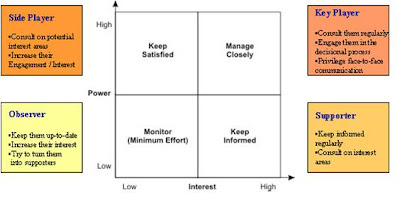In any entrepreneurial activities bringing about changes you will have to deal with individuals or groups interested in the outcome or simply impacted by your project or program.
Depending on the breadth of your project or program, the list of stakeholders can encompass public government, media, public opinion influencers and corporate management.
Independently from the constituency you are referring to as a manager willing to ensure the highest probability of success to your initiatives you have to engage them.
Managers need to think of Stakeholder Engagement not only as a set of tasks to execute, but also as a way of achieving influence and positive outcomes through effective management of relationships.
In order to reach this virtuous balance, in designing your management strategy you have to identify all your stakeholders and analyze their profile in the context of the project or program you are operating.
The identification phase takes different shapes but usually it utilizes one or more of the following approach
- Brainstorm with your team
- Analyze the project brief or the program mandate to discover impacted people or groups
- Utilize historical information from similar projects
- Seek the advice of identified stakeholders to determine whether there are groups or subgroups you have overlooked
As well you will have to single out the domain of interest on the project for every stakeholder.
For example, some stakeholders will be concerned with how a program will affect their business processes while others will focus on the way a program will modify the reporting system.
The analysis of the interest areas for each group can be represented in a matrix - a Stakeholder Map. The Stakeholder Map in the following figure compares the various stakeholders against their interests in a project dealing with the implementation of a new reporting and finance package.

Once identified the interest areas you have to consider the stakeholder potential interest in the program/project outcomes as well as the power (influential or positional) of each stakeholder.
This evaluation is important since it will allow you to plan the effort you invest on each stakeholder and to develop a communication plan that is aligned to each stakeholder or stakeholder group's focus and concerns.
A common approach is to map the interest and influence of each stakeholder group on a quadrant of an Influence / Interest Map and structure an engagement strategy for each group as illustrated in the following picture.

Because of the evolving nature of each project or program, the Stakeholder Map and the Influence / Interest Map should be regularly revisited and checked to see whether other stakeholders have now appeared, new interests have emerged and whether earlier assessments of stakeholders should now be modified.
So revising the initial collected information throughout the program is crucial to ensuring appropriate communication strategies and approaches for stakeholder engagement.
And a timely stakeholder analysis can help a project or program manager identify potential conflicts or risks, expectation misalignment as well as changes and opportunities.

1 comment:
I appreciate the labor you have put in developing this blog. Nice and informative.
Post a Comment